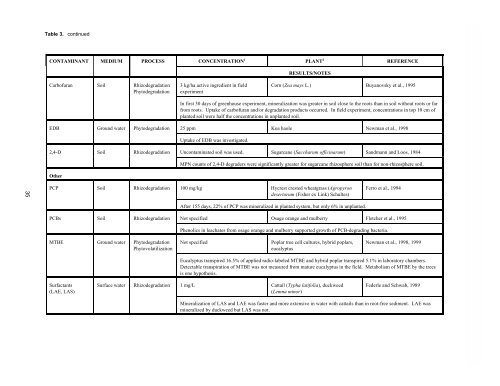Ground Water Issue - Plant Tissue Culture Research at the Univ. of ...
Ground Water Issue - Plant Tissue Culture Research at the Univ. of ...
Ground Water Issue - Plant Tissue Culture Research at the Univ. of ...
Create successful ePaper yourself
Turn your PDF publications into a flip-book with our unique Google optimized e-Paper software.
Table 3. continuedCONTAMINANT MEDIUM PROCESS CONCENTRATION 1 PLANT 2 REFERENCERESULTS/NOTESCarb<strong>of</strong>uran Soil Rhizodegrad<strong>at</strong>ionPhytodegrad<strong>at</strong>ion3 kg/ha active ingredient in fieldexperimentCorn (Zea mays L.) Buyanovsky et al., 1995In first 30 days <strong>of</strong> greenhouse experiment, mineraliz<strong>at</strong>ion was gre<strong>at</strong>er in soil close to <strong>the</strong> roots than in soil without roots or farfrom roots. Uptake <strong>of</strong> carb<strong>of</strong>uran and/or degrad<strong>at</strong>ion products occurred. In field experiment, concentr<strong>at</strong>ions in top 10 cm <strong>of</strong>planted soil were half <strong>the</strong> concentr<strong>at</strong>ions in unplanted soil.EDB <strong>Ground</strong> w<strong>at</strong>er Phytodegrad<strong>at</strong>ion 25 ppm Koa haole Newman et al., 1998Uptake <strong>of</strong> EDB was investig<strong>at</strong>ed.2,4-D Soil Rhizodegrad<strong>at</strong>ion Uncontamin<strong>at</strong>ed soil was used. Sugarcane (Saccharum <strong>of</strong>ficinarum) Sandmann and Loos, 1984O<strong>the</strong>rMPN counts <strong>of</strong> 2,4-D degraders were significantly gre<strong>at</strong>er for sugarcane rhizosphere soil than for non-rhizosphere soil.35PCP Soil Rhizodegrad<strong>at</strong>ion 100 mg/kg Hycrest crested whe<strong>at</strong>grass (Agropyrondesertorum (Fisher ex Link) Schultes)Ferro et al., 1994After 155 days, 22% <strong>of</strong> PCP was mineralized in planted system, but only 6% in unplanted.PCBs Soil Rhizodegrad<strong>at</strong>ion Not specified Osage orange and mulberry Fletcher et al., 1995Phenolics in leach<strong>at</strong>es from osage orange and mulberry supported growth <strong>of</strong> PCB-degrading bacteria.MTBE <strong>Ground</strong> w<strong>at</strong>er Phytodegrad<strong>at</strong>ionPhytovol<strong>at</strong>iliz<strong>at</strong>ionNot specifiedPoplar tree cell cultures, hybrid poplars,eucalyptusNewman et al., 1998, 1999Eucalyptus transpired 16.5% <strong>of</strong> applied radio-labeled MTBE and hybrid poplar transpired 5.1% in labor<strong>at</strong>ory chambers.Detectable transpir<strong>at</strong>ion <strong>of</strong> MTBE was not measured from m<strong>at</strong>ure eucalyptus in <strong>the</strong> field. Metabolism <strong>of</strong> MTBE by <strong>the</strong> treesis one hypo<strong>the</strong>sis.Surfactants(LAE, LAS)Surface w<strong>at</strong>er Rhizodegrad<strong>at</strong>ion 1 mg/L C<strong>at</strong>tail (Typha l<strong>at</strong>ifolia), duckweed(Lemna minor)Federle and Schwab, 1989Mineraliz<strong>at</strong>ion <strong>of</strong> LAS and LAE was faster and more extensive in w<strong>at</strong>er with c<strong>at</strong>tails than in root-free sediment. LAE wasmineralized by duckweed but LAS was not.
















